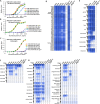Discovery of anti-SARS-CoV-2 S2 protein antibody CV804 with broad-spectrum reactivity with various beta coronaviruses and analysis of its pharmacological properties in vitro and in vivo
- PMID: 39621673
- PMCID: PMC11611099
- DOI: 10.1371/journal.pone.0300297
Discovery of anti-SARS-CoV-2 S2 protein antibody CV804 with broad-spectrum reactivity with various beta coronaviruses and analysis of its pharmacological properties in vitro and in vivo
Abstract
The SARS-CoV-2 pandemic alerted the potential for significant harm due to future cross-species transmission of various animal coronaviruses to human. There is a significant need of antibody-based drugs to treat patients infected with previously unseen coronaviruses. In this study, we generated CV804, an antibody that binds to the S2 domain of SARS-CoV-2 spike protein, which is highly conserved across the coronavirus family and less susceptible to mutations. CV804 demonstrated broad cross-reactivities not only disease-associated human beta coronaviruses including SARS-CoV, MERS-CoV, HCoV-OC43, HCoV-HKU1 and with existing mutant strains of SARS-CoV-2 and but also with 20 representative animal-origin coronaviruses. CV804 exhibits strong antibody-dependent cellular cytotoxicity (ADCC) to SARS-CoV-2 spike protein expressed on cells in vitro, while completely lacks virus-neutralization activity. In animal models, CV804 suppressed disease progression caused by SARS-CoV-2 infection. Structural studies using HDX-MS combined with reactivity analysis with point mutants of recombinant spike proteins revealed that CV804 binds to a unique conformational epitope within the S2 domain of the spike proteins that is highly conserved among various coronaviruses. Overall, obtained data suggest that the non-neutralizing CV804 antibody recognizes the conformational structure of the spike protein displayed on the surface of infected cells and weakens the viral virulence by supporting the host immune cells' attack through ADCC activity in vivo. The CV804 epitope information revealed in this study is useful for designing pan-corona antibody therapeutics and universal coronavirus vaccines for preparing potential future pandemics.
Copyright: © 2024 Tsugawa et al. This is an open access article distributed under the terms of the Creative Commons Attribution License, which permits unrestricted use, distribution, and reproduction in any medium, provided the original author and source are credited.
Conflict of interest statement
The authors have declared that no competing interests exist.
Figures




References
MeSH terms
Substances
LinkOut - more resources
Full Text Sources
Medical
Miscellaneous

